Kneel at the crossroads of Masonic secrets and biblical texts, where ancient symbols and stories whisper truths waiting to be unveiled.
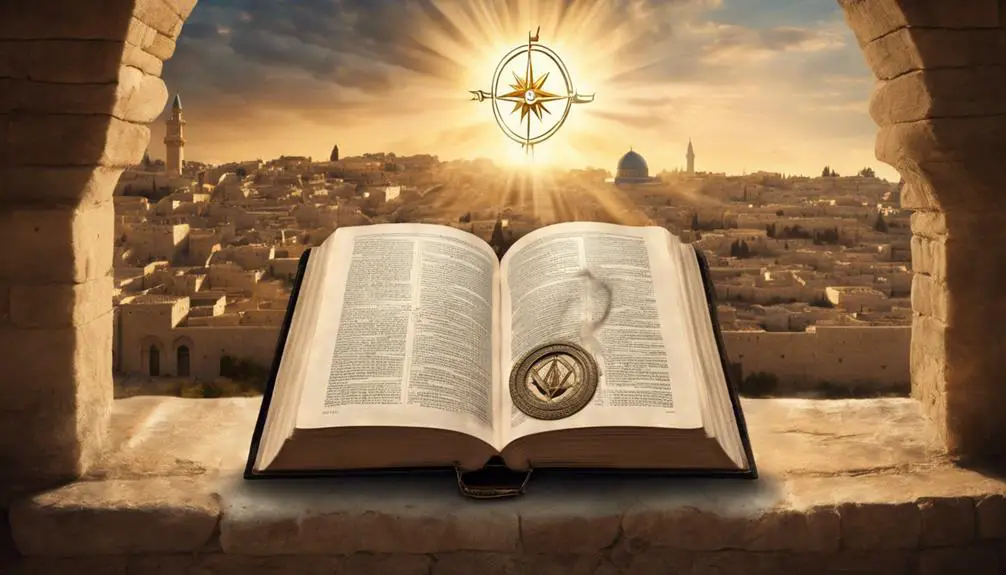
Masonic References in the Bible
While you might think the Bible and Freemasonry are worlds apart, you'd be intrigued by the subtle connections and references that suggest otherwise. From the legend of Hiram Abiff to the rich symbolism of Solomon's Temple, including the cornerstone and the pillars of strength and establishment, these references are not just coincidental.
The metaphors of light and darkness further enrich this fascinating intersection. This exploration offers a unique perspective on familiar biblical narratives and Masonic traditions, inviting you to consider the deeper implications of these ancient texts and rites in a new light.
What will you discover in the shadows of these storied pages?
Key Takeaways
- Masonic rituals incorporate Biblical figures like King Solomon and Hiram Abiff, emphasizing moral integrity and brotherhood.
- Symbols such as the Square and Compass in Masonic lore find parallels in Biblical narratives, underlining spiritual and ethical teachings.
- Architectural elements like Solomon's Temple in the Bible carry significant Masonic symbolism, representing moral foundations and divine wisdom.
- Biblical stories and Masonic allegories both stress the importance of virtues like fidelity, charity, and justice in spiritual enlightenment.
The Legend of Hiram Abiff
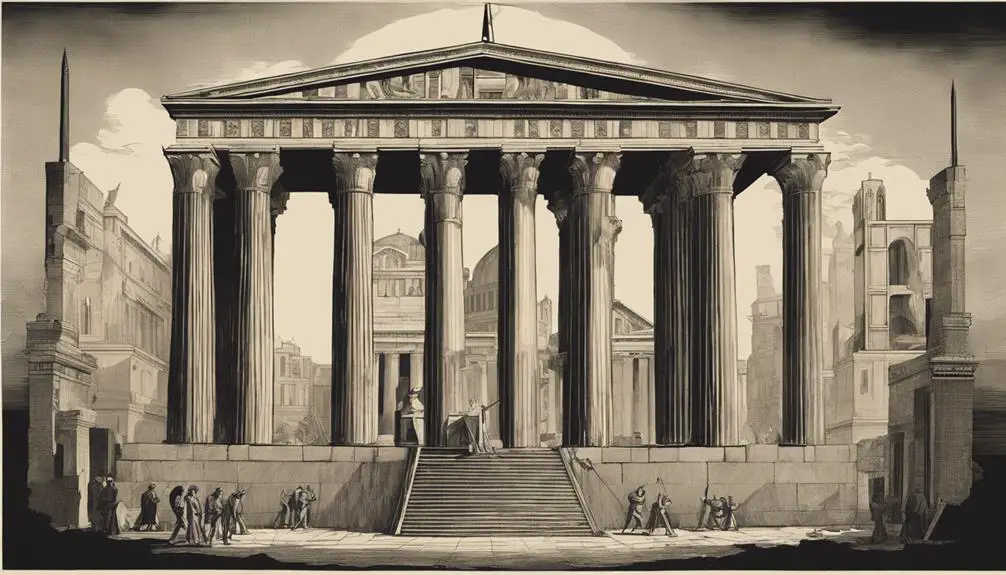
Central to Masonic lore, the legend of Hiram Abiff encapsulates profound allegorical significance, often interpreted as a symbol of fidelity and the eternal struggle between light and darkness. This narrative, while not directly found in the Bible, complements biblical themes through its moral allegory and emphasis on virtue. You'll find that the story serves as a cornerstone for ritual initiation in Freemasonry, embodying principles that are integral to the Masonic philosophy.
The legend operates as a moral compass for Masons, guiding them in their personal development and communal responsibilities. It's a vivid illustration of loyalty, integrity, and the repercussions of betraying sacred trusts. Through the trials of Hiram Abiff, you're invited to reflect on the essence of moral fortitude and the importance of steadfastness in the face of adversity.
Furthermore, the story's depiction of Hiram Abiff's journey through darkness into light is a potent symbol for the transformative power of truth and knowledge. It underscores the belief in personal growth and enlightenment as central to Masonic ritual initiation. In essence, the legend of Hiram Abiff serves not only as a narrative of moral allegory but also as a foundational myth that shapes the ethical framework and symbolic practices of Freemasonry.
Solomon's Temple Imagery
Solomon's Temple, a key symbol within both biblical narratives and Masonic tradition, embodies a rich tapestry of allegorical meaning and spiritual significance. This edifice, meticulously described in the Scriptures, serves as more than just a historical or architectural figure; it's a complex symbol interwoven with layers of metaphysical and theological motifs that resonate deeply within Masonic lore. To understand its profound impact, consider the following elements:
- Architectural Design: The Temple's grandeur and intricate design reflect not only an architectural marvel but also symbolize the order and harmony of the universe, echoing the Masonic emphasis on building one's spiritual edifice.
- Ark's Significance: Positioned in the Temple's inner sanctum, the Ark represents God's presence and the embodiment of the covenant between God and the Israelites. Its symbolic representation underscores themes of divine guidance and moral rectitude.
- Ceremonial Functions: The rituals and ceremonies performed within its confines are rich with symbolism, offering insights into the esoteric teachings that Masonry embraces, particularly around spiritual purification and enlightenment.
- Covenant Details: The detailed covenant that the Temple's construction and existence signify, including the Ark's role in this relationship, highlights themes of fidelity, divine law, and the quest for spiritual truth.
Analyzing Solomon's Temple imagery within Masonic references reveals a profound connection to biblical principles, emphasizing moral integrity, divine wisdom, and the eternal quest for spiritual enlightenment.
The Cornerstone Symbolism
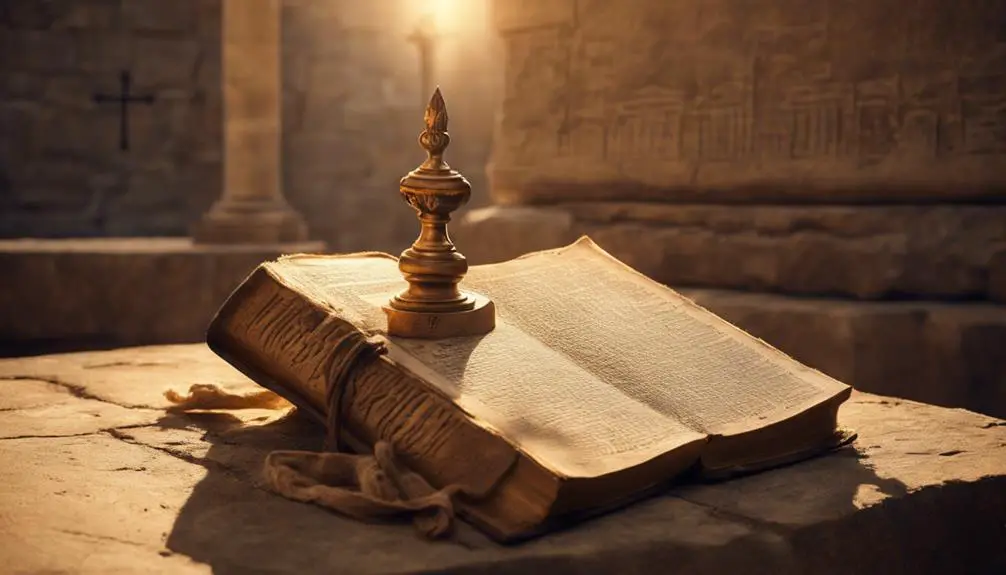
In the exploration of Masonic symbolism, the cornerstone holds a pivotal place, representing the foundational element upon which moral and spiritual edifices are constructed. Its architectural significance is profound, serving as the literal and metaphorical base for structures. In a spiritual context, the cornerstone symbolizes the beginning of a faithful journey, anchoring the believer's path in righteousness and strength.
The Bible references this symbolism in various passages, highlighting its importance not only in physical construction but also in spiritual teachings. The cornerstone's dual significance offers a rich tapestry of meanings for those seeking deeper understanding.
Aspect |
Architectural Significance |
Spiritual Metaphor |
|---|---|---|
Foundation |
Essential for stability and integrity of structures. |
Represents faith's role in personal development. |
Orientation |
Dictates the alignment of the entire structure. |
Guides moral and ethical direction. |
Unity |
Joins two walls at the building's corner. |
Symbolizes the joining of divine and human elements. |
Endurance |
Must be strong to support weight over time. |
Reflects perseverance in faith and life's trials. |
The Pillars of Strength and Establishment
While examining the rich tapestry of Masonic symbols, it's essential to explore the significance of the pillars, which serve as emblematic representations of strength and establishment within both architectural and spiritual realms. These structures aren't merely physical entities; they embody a profound depth of meaning that transcends their stonework.
- Architectural Significance: The pillars aren't just about the grandeur of physical construction but symbolize the robust foundation upon which wisdom and strength rest. They remind you of the importance of building your life on principles that are both sturdy and enduring.
- Cultural Interpretations: Across various cultures, these pillars have been seen as gateways between the divine and the earthly, suggesting a bridge between man and the sacred. This duality highlights how strength and establishment are pivotal in both the material and spiritual journeys.
- Symbolic Representation: In Masonic tradition, pillars represent two key aspects: *Boaz*, symbolizing strength, and *Jachin*, indicating establishment. Together, they form a gateway to enlightenment, emphasizing the balance necessary for personal and communal growth.
- Moral Foundations: The emphasis on these pillars within Masonic teachings encourages a reflection on the moral backbone required to uphold societal and individual integrity. They serve as a constant reminder of the virtues needed to sustain and nurture a just and equitable society.
Analyzing these pillars within Masonic references in the Bible reveals a layered understanding of their architectural significance and cultural interpretations, offering insights into their broader symbolic resonance.
Light and Darkness Metaphors
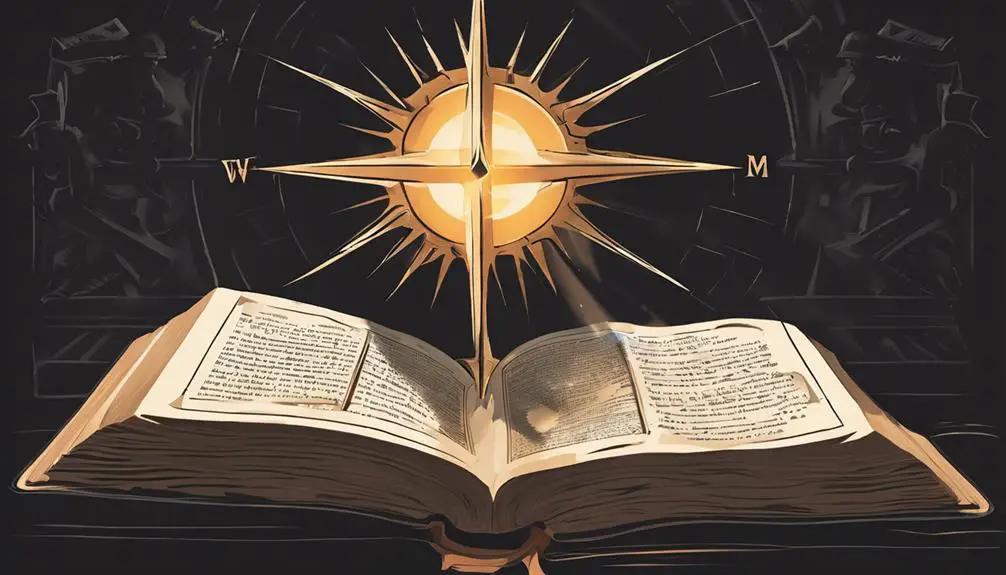
Delving into Masonic symbolism, one cannot overlook the profound use of light and darkness metaphors, serving as archetypal reflections of moral and spiritual duality. These metaphors, deeply embedded in the Creation narrative, illustrate the contrast between knowledge and ignorance, virtue and vice, clearly embodying the concept of moral dualism. This duality is not only central to Masonic teachings but is also a foundational element in the biblical narrative, offering layers of interpretation and moral guidance.
Light Metaphors |
Darkness Metaphors |
|---|---|
Symbol of divine wisdom |
Represents ignorance |
Embodies truth and knowledge |
Associated with evil and corruption |
Reflects purity and virtue |
Signifies moral failings |
Marks the beginning of Creation |
Represents chaos before order |
Sign of hope and guidance |
Portrays despair and misguidance |
Through these metaphors, the Bible conveys complex concepts of ethical and spiritual significance, inviting readers to reflect on the path from darkness to light as a journey towards enlightenment and moral perfection. These allegories serve not only as religious guidance but also as moral compasses, illustrating the perpetual struggle between good and evil, light and darkness, within the human experience.
Frequently Asked Questions
How Do Modern Masonic Rituals and Teachings Directly Relate to Specific Bible Verses or Stories Outside the Commonly Cited References to Solomon's Temple and the Legend of Hiram Abiff?
You're exploring how modern Masonic rituals and teachings connect to biblical narratives beyond Solomon's Temple and Hiram Abiff.
Look into charity interpretations and architectural metaphors within the Bible.
These elements offer deeper insights into Masonic symbolism and ethics.
Analyzing these connections reveals how Masonry embodies biblical principles in its ceremonies and moral teachings, illustrating a rich, layered relationship that extends well into various aspects of Masonic tradition and practice.
Are There Any Notable Differences in the Interpretation of Biblical Stories or Symbols Between Various Masonic Rites (E.G., Scottish Rite Vs. York Rite) and How Do These Interpretations Impact Masonic Practices or Beliefs?
Yes, you'll find that the interpretation of stories and symbols can vastly differ between Masonic rites, like the Scottish Rite versus the York Rite.
These differences aren't just academic exercises; they're the bedrock of ritual origins and shape the symbolic architecture of Masonic practices and beliefs.
Analyzing these variations offers insights into how Masonry adapts and evolves, reflecting the diverse approaches to spirituality and morality within the fraternity.
How Has the Perception of Masonic References in the Bible Changed Over the Centuries, Particularly With the Evolution of Biblical Scholarship and Archaeology?
You've noticed that perceptions of ancient texts, especially regarding symbolic interpretations, have evolved significantly with advances in biblical scholarship and archaeology. Ancient manuscripts have been pivotal in this shift, altering how scholars view historical contexts and meanings.
This evolution reflects a broader understanding of how interpretations have changed over centuries, impacting fields that delve into the symbolic, including those analyzing texts for esoteric or philosophical insights.
Can You Identify Any Biblical Figures Other Than Solomon and Hiram Abiff Who Are Symbolically Significant in Freemasonry, and What Aspects of Their Stories Are Emphasized?
You're diving into stories beyond Solomon and Hiram Abiff, finding figures like Noah and those involved with the Tower of Babel. Noah's Ark symbolizes rebirth and initiation, pivotal in Masonic teachings.
Meanwhile, the Tower of Babel's narrative highlights unity and the dangers of pride, resonating deeply with Freemasonry's values. These tales aren't just biblical stories; they're foundational myths that shape Masonic symbolism and principles, emphasizing moral and spiritual lessons.
How Do Freemasons Reconcile Discrepancies Between Biblical Teachings and Masonic Rituals or Beliefs, Especially in Contexts Where Interpretations Might Conflict?
You're tackling how Freemasons manage potential conflicts between their rituals or beliefs and biblical teachings.
Freemasons often view these discrepancies as symbolic rather than literal conflicts. They lean on allegorical interpretations and emphasize the principles of moral and ethical teachings, such as charity, which align with biblical virtues.
Through this lens, Freemasons reconcile differences by focusing on the underlying moral lessons, rather than the literal narrative, bridging any apparent gaps.
Conclusion
In conclusion, while some argue that Masonic references in the Bible are purely coincidental, a closer analysis reveals a deeper interconnection. The legend of Hiram Abiff, Solomon's Temple imagery, cornerstone symbolism, and the pillars, alongside light and darkness metaphors, all resonate with Masonic teachings.
This isn't to say the Bible serves as a Masonic text, but rather that the shared symbols and stories suggest a rich, historical interplay that merits scholarly attention. This intersection enriches our understanding of both traditions.

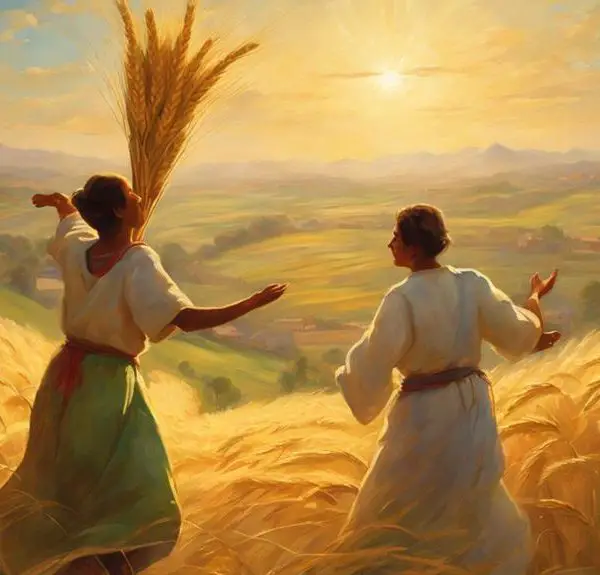
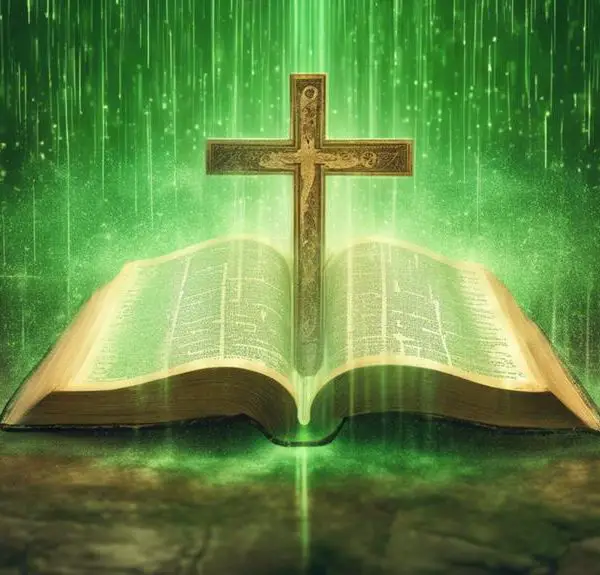
Sign up